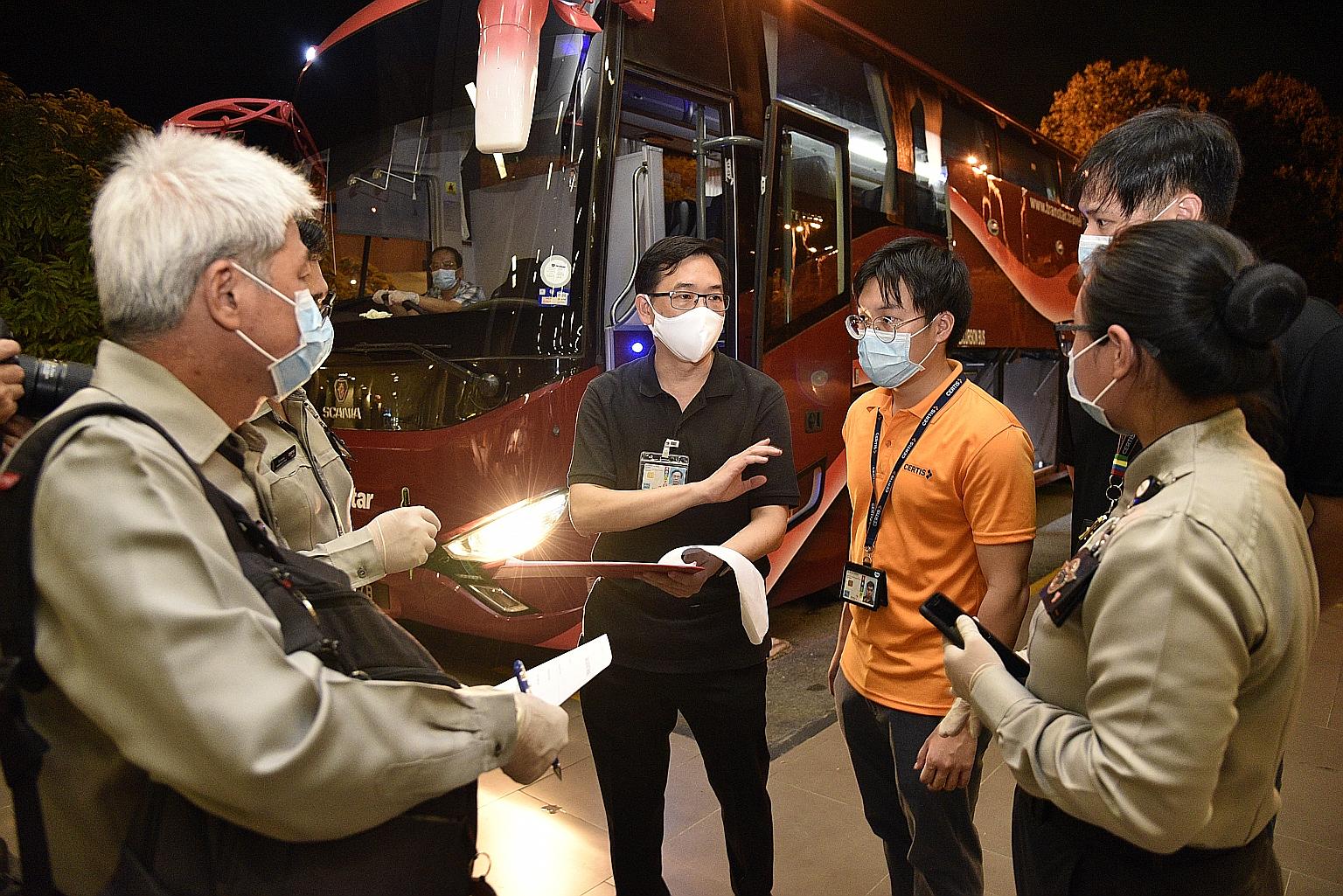Coronavirus: Few flights at Changi Airport but checks stepped up for returnees
Flights down to 80 a week at Changi; those arriving cleared through multi-step process
Sign up now: Get ST's newsletters delivered to your inbox

Mr Bernard Lim (right), senior director of the Ministry of Transport's international relations and security division, speaking to his team outside the Terminal 3 coach area on Sunday.
ST PHOTO: DESMOND WEE
Tee Zhuo
Follow topic:
The pandemic has taken its toll on passenger numbers at Singapore's once-bustling Changi Airport, but this may not mean less work for ground officers who now have to clear those arriving in Singapore through a multi-step process.
Flights have trickled to 80 a week from the 7,400 in normal times, and planes that used to pack hundreds now carry as few as 10.
In a Facebook post last Friday, Transport Minister Khaw Boon Wan said the airport now handles only around 100 arrival and 700 departure passengers a day.
While flights used to connect the airport to about 380 cities, incoming flights from fewer than 10 cities have continued. They include London, Frankfurt, Los Angeles, Jakarta, Manila, Tokyo and Kuala Lumpur.
Yet even as air traffic has plummeted, Covid-19 has presented greater challenges to clearing arriving passengers - now almost solely returning Singapore residents.
Since Jan 30, the Ministry of Transport (MOT) has been coordinating a joint effort between several agencies to manage the process of handling returning residents at Changi Airport, as the Republic gradually expanded stay-home notice and quarantine requirements to more locations.
To date, more than 7,000 such returnees have been assisted.
Agencies involved include the Civil Aviation Authority of Singapore and the Immigration and Checkpoints Authority, as well as security firm Certis and Raffles Medical Group.
Mr Bernard Lim, senior director of MOT's international relations and security division, said officers from various agencies work in three shifts that are about eight hours each, and they take about half an hour to an hour to prepare beforehand.
The process begins the day before, where data is gathered from the airlines about the number of returnees, so that hotels and shuttle buses can be prepared in advance.
After passengers exit their airplane, they walk past two sets of thermal scanners which monitor their temperatures. Those who have a high temperature or who are unwell are taken to medical points for check-ups.
If suspected of having Covid-19, they are taken immediately by ambulance to the National Centre for Infectious Diseases.
Otherwise, returnees proceed to the immigration checkpoint where they are issued a stay-home notice.
After they collect their baggage, they go to a bay where buses will take them to one of 33 hotels prepared to house them for the 14-day stay-home period, a requirement for all returnees since 11.59pm on April 9.
The entire process, which involves between 15 and 20 officers from around eight agencies, can be completed in half an hour.
Despite the added precautions and steps, returning Singaporeans who spoke to The Straits Times found the process a breeze.
Ms Memta R. Jagtiani, 24, who returned from London on a Singapore Airlines (SIA) flight last Tuesday, estimated that it took half an hour from the time she disembarked at Terminal 3 to the time she boarded her bus bound for Swissotel The Stamford.
"Staff at the airport were quite helpful - they took my luggage off the belt for me. The whole process went very smoothly, and quickly," said the doctoral student at University College London.
Similarly, Ms Denise Cheah, 25, a medical graduate from the University of Cambridge, also said she was quite impressed by how swiftly everything moved.
She returned on an SIA flight from London on April 1 - days after the stay-home rule had kicked in for those returning from Britain and the United States from 11.59pm on March 25.
MOT and other agencies have also helped some foreign nationals - from Chile, the Netherlands, Australia, Poland and Malaysia, among others - to transit at Changi, at the request of their embassies.
Mr Lim said these passengers either remain on board the aircraft while it refuels, or in "exceptional cases" disembark and transfer to another aircraft parked a short walking distance away.
The operations at Changi Airport involve a lot of coordination and logistics, said Mr Lim, who added that reviews are done after each flight to see what can be improved.
"Through what we are doing at the airport, we want those returning to know that Singapore cares for them, and we are glad that they have come home safely."

